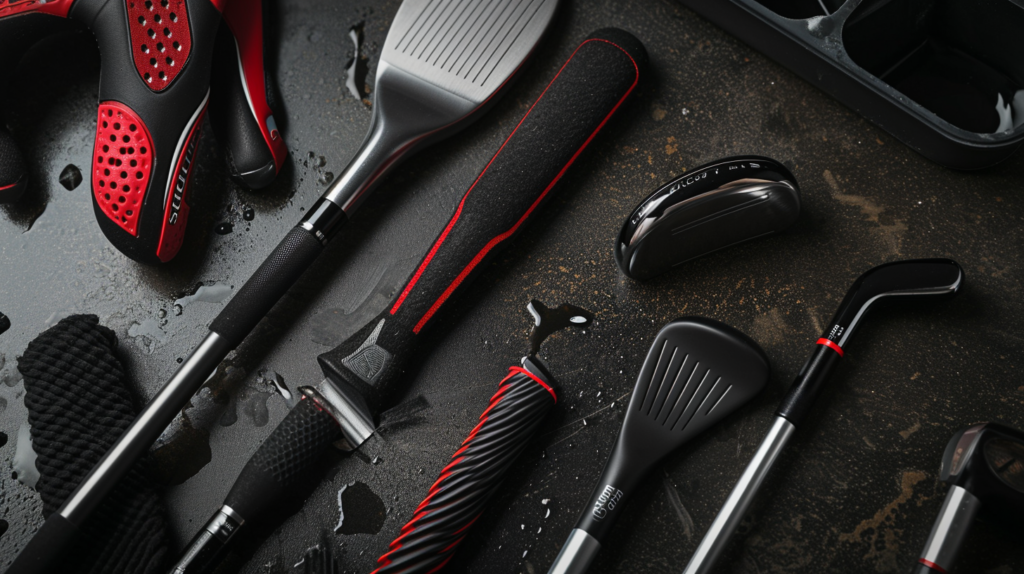Do your golf grips feel worn, slippery, or uncomfortable during your swing? Properly regripping clubs could hold the key to better performance.
Replacing old, worn golf club grips restores grip comfort and function essential for proper ball striking, distance control, and consistency.
Let’s dive into when you should regrip clubs, the regripping process, and best practices for maximum playability so you can improve your grip game.
Why Regripping Golf Clubs is Important

Properly gripping your golf clubs is essential for proper ball striking, distance control, and achieving consistency in your golf game. Over time, golf grips can become worn, hardened, or simply feel uncomfortable in your hands.
Regripping your clubs restores grip function and allows you to optimize comfort and performance.
There are several signs that indicate it is time to replace your golf club grips:
The first paragraph explains the importance of regripping worn golf club grips and introduces the reasons someone would need to regrip their clubs.
When You Should Regrip Your Golf Clubs

You should consider regripping your golf clubs if you notice any of the following:
The golf grips feel slick or show visible wear. As the rubber compound in golf grips breaks down from use, oils come to the surface, causing the grip to feel slick, especially when moisture from sweat and humidity is present.
Visible wear like cracking or peeling also indicates the rubber is breaking down. Slick, worn grips make it hard to hold the club securely.
The second paragraph covers visible signs of grip wear and deterioration that indicate it’s time for new grips.
The rubber has hardened over time. Even if they aren’t visibly worn, golf grips can lose elasticity and feel hard and unforgiving over years of use.
Hardened rubber does not absorb vibration or conform to your hands well, causing discomfort.
Replacing hardened, inflexible grips restores shock absorption for better comfort and feel.
The golf grips feel sticky or tacky. On the other side of hardening, some golf grips become soft and gummy over time.
This sticky feel can cause clubs to twist in your hands during the swing. Sticky grips need replacement.
You notice changes in grip comfort and performance. Even before visible wear happens, you may notice subtle changes in how secure and comfortable the golf clubs feel in your hands due to the breakdown of the grip material.
These changes likely indicate it is time for new grips.
You want to update the texture, size, or material. Golf grip technology keeps improving, with new materials and patterns continually coming out.
You might want to experiment with rubber compounds, cord patterns, or grip sizes that improve feel and performance. Re-gripping provides an opportunity to test out the newest grip technologies.
The third and fourth paragraphs cover the feel and performance deterioration of golf grips over time that indicate the need for regripping.
Materials Needed for Regripping

Re-gripping golf clubs requires gathering the correct supplies and having a working area where you can let materials cure overnight. Before starting, gather the following materials:
New replacement golf grips that match your club model and size requirements. Make sure to purchase a full replacement set so all your grips match.
Grip tape solvent allows removing old grips and cleaning grips thoroughly for the best bond with new grips. It also serves as an adhesive when installing new grips.
The solvent requires proper ventilation when in use and needs to cure fully after grip installation.
A grip tape applicator brush evenly spreads solvents and grip cement when preparing shafts and installing grips. It features a reservoir to hold the solvent and a convenient roller applicator.
The fifth paragraph introduces the basic supplies needed to properly regrip golf clubs.
Double-sided grip tape secures the new grip at the top of the shaft. The tacky grip tape keeps grips from slipping down during play.
Make sure to use high-quality grip tape specifically designed for golf.
A sharp scissors or razor blade cleanly cuts grip tape and precisely trims the bottom of replacement grips once installed to create an even edge.
Masking tape secures the shaft tip during the process to keep solvents out of the hosel and head of the club. Tape also prevents debris from getting into the shaft.
Grip winding tape evenly increases grip diameter for those who need oversized grips for proper hand placement. Build-up tape comes in 1/32 inch increments, allowing precise grip adjustments.
The sixth paragraph covers additional tools and tape products needed during the regripping process.
An air compressor with blow gun thoroughly sets the installed grips once cured using blasts of high-pressure air. The air blast ensures a tight bond between grip and shaft.
Proper eye protection, solvent-resistant gloves, and ventilation protects against grip solvent fumes during the process. Have a well-ventilated garage or workshop area for best results.
Paragraphs seven and eight explain the post-installation equipment and safety gear needed to professionally regrip golf clubs.
Step-by-Step Process for Regripping Golf Clubs

Here is the step-by-step process with headings for each step:
Step-by-Step Process for Regripping Golf Clubs
With the right supplies gathered, you can now walk through the complete golf club re-gripping process step-by-step:
1. Remove Old Grip
Remove the old grip using a sharp blade and solvent. Cut downward directly in line with the shaft to avoid cutting into the shaft tape underneath.
Soak remaining tape residue with solvent and use a plastic scraper to remove tape fragments cleanly.
2. Clean and Prepare Shaft
Thoroughly wipe down the bare shaft with solvent to remove all dirt, oils, old tape, or debris. Cotton cloths work well for cleaning.
Inspect for any burrs or imperfections on the shaft and sand lightly if needed.
3. Apply Grip Solvent Cement
Apply two coats of grip solvent cement along the entire shaft, using an applicator brush. Make sure to coat evenly up to the very top of the bare shaft below the taper.
Let the first coat become tacky before the second application. The cement ensures proper bonding between the grip and shaft.
4. Wrap Grip Tape
Evenly wrap double-sided grip tape up the entire shaft, centered along the spine. Start just below the shaft taper and wrap down applying firm pressure.
The tape provides tackiness and cushioning for the replacement grip.
5. Install New Grip
Slide the new replacement grip onto the shaft, aligning logos straight up and ensuring proper orientation. Slowly work down evenly to avoid air bubbles.
Leave 1/8 inch of bare tape showing at the very bottom of the installed grip.
6. Secure Top Grip Tape
Secure grip tape at the very top of the shaft to prevent slippage, tightly wrapping tape over the grip edge onto the shaft approximately 2 inches. Press firmly to bond the tape.
Remove clubhead masking tape once set.
7. Allow Proper Cure Time
Allow the solvent cement to cure fully per manufacturer instructions, typically overnight, before trimming the bottom of the grip or using the club. The bond between grip and shaft strengthens over the first 24 hours. Insufficient curing can cause newly installed grips to spin or slip.
8. Trim Excess Grip Length
Use a sharp utility blade to trim off any excess grip length flush with the shaft butt end, reestablishing the proper overall club length following installation. Take care not to cut deep into the grip surface.
Sand lightly to remove any burrs left after cutting.
Best Practices for Golf Grip Installation

Taking proper care throughout the golf grip replacement process ensures maximum playability and longevity of newly installed grips:
Carefully follow all solvent manufacturer safety precautions during removal and installation to avoid respiratory or skin irritation. Work in a well-ventilated location and use protective equipment.
Rushing can lead to splashing solvents and poor grip bonding.
Ensure you choose the best grip size, texture, and firmness to match your preferences, glove wear habits, regional weather, and swing style through experimentation. Install various demo grips before settling on a replacement model best optimized for you.
Consider checking with your club professional for fitting advice as well. Properly fit grips promote ideal hand placement and comfort.
The final sections offer best practice tips for safely managing grip solvents, properly selecting grip features, achieving robust grip tape bonds, fully curing adhesives, and cleanly trimming off excess grip length after installation.
Keep all solvents and debris away from the clubhead hosel and shaft interior by securely taping off areas. Contaminants can affect clubhead bonding and shaft integrity.
Thoroughly insert a shop towel into the hosel opening while working well down into the shaft interiors.
Carefully set twin-sided grip tape during wrapping to minimize air pockets or gaps between the tape and shaft. Gently work from the middle outward squeezing bubbles free while maintaining tape alignment.
Rushed or sloppy tape application negatively impacts bond strength.
Allowing full solvent cement cure times before swinging newly gripped clubs ensures the most robust bonds, avoiding grip rotation or slippage during play. Grips may feel fully bonded prior to the recommended cure period but require the specified duration to reach optimum strength.
Insufficient curing risks bonding failure, grip movement, and injury.
Use a new, perfectly straight razor blade with each set of grips replaced to achieve crisp, smooth trim cuts along the grip bottom edges.
Worn blades can catch or tear the grip material rather than slicing cleanly. Lightly sand any minor burrs left from cutting using fine grit sandpaper taking care not to round over the crisp lower grip lines.
Conclusion
Properly regripping worn golf grips restores grip comfort and function while allowing customization of texture, firmness, and sizes.
Following careful processes for grip removal, preparation, solvent usage, installation, curing, and trimming results in secure, long-lasting grip performance. Using quality solvents, tapes, replacement grips and taking proper safety precautions gives the best regripping results.
Regripping golf clubs periodically helps maintain proper swing mechanics, ball striking, and arm health for more enjoyment on the course.



